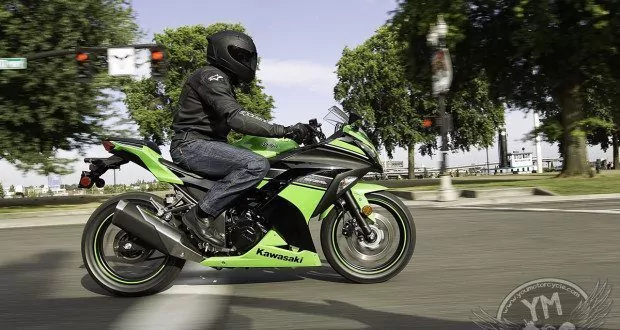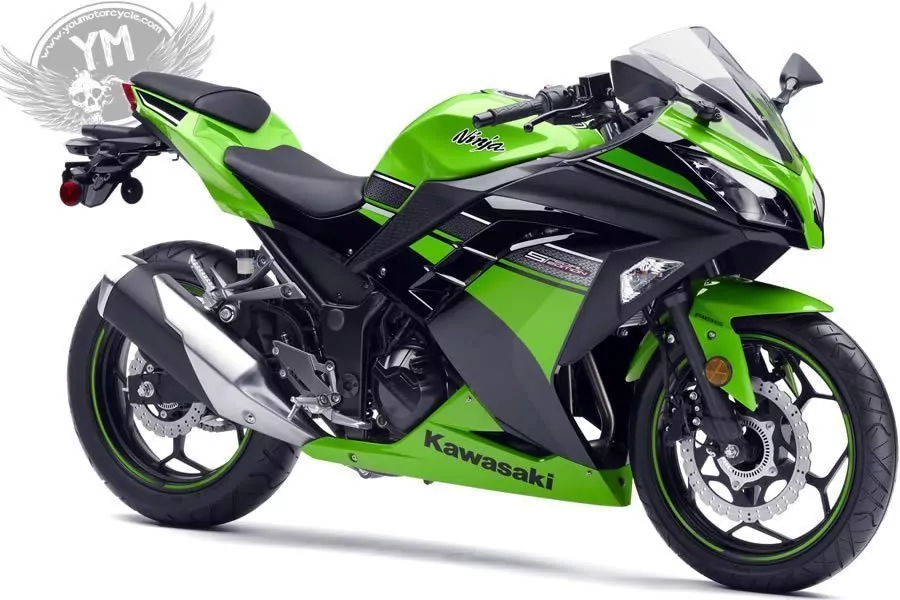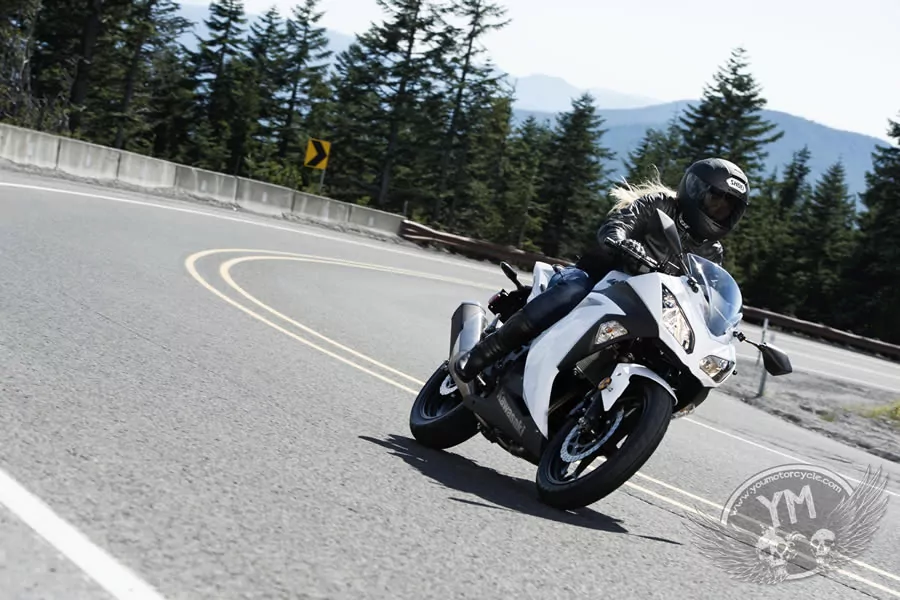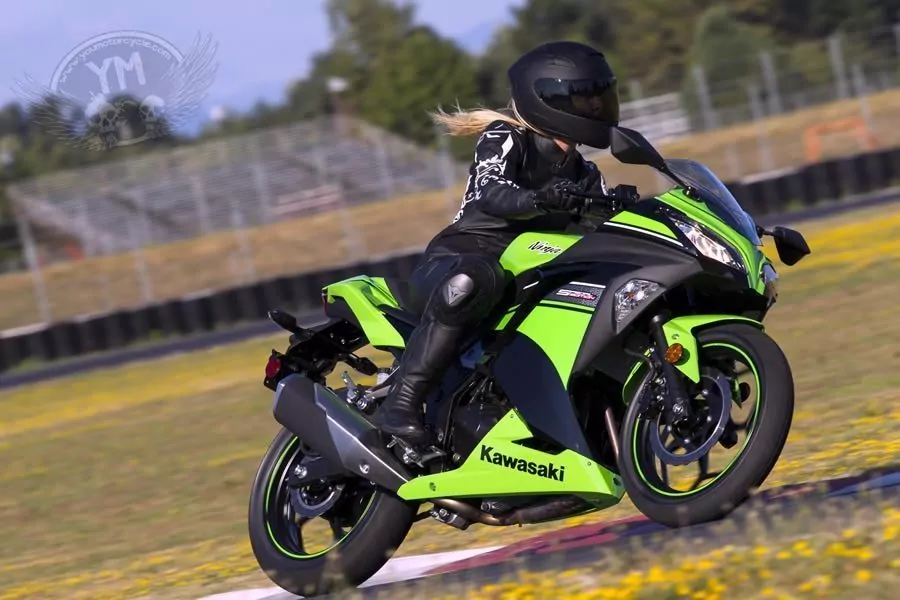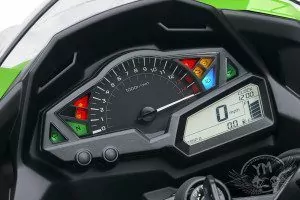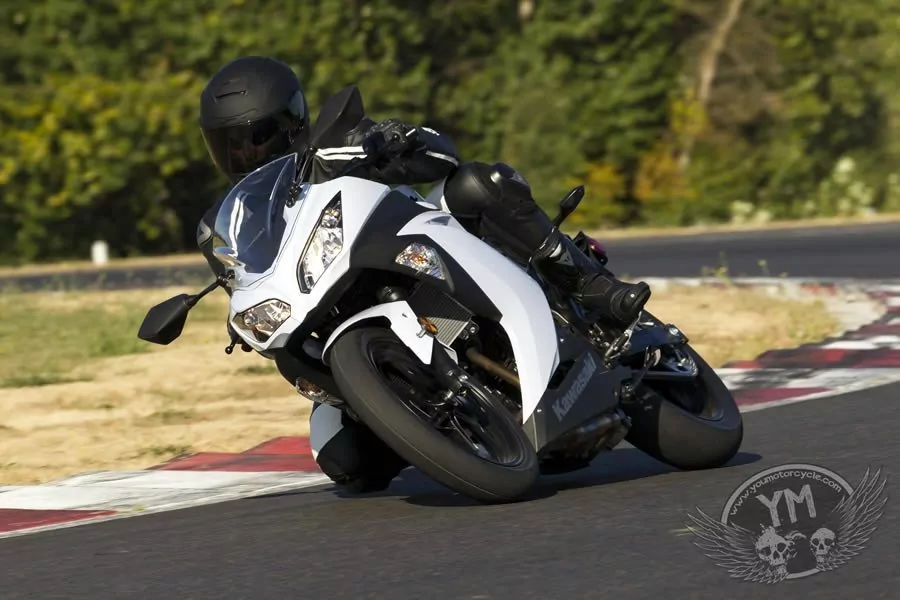The much anticipated 2013 Kawasaki Ninja 300R comes with an all new 296cc parallel twin designed to outperform motorcycles such as the 2013 Honda CBR250R, or the older Ninja 250R it replaces. The new ergonomics, sporty look, and multi-functional LCD are extra perks for the veteran urban commuter or beginner motorcyclist alike.
The engine parts and basic configuration are almost the same as the Ninja 300R’s predecessor the Kawasaki Ninja 250, but the upgrades are unmistakable. The extra 47 cubic centimeters deliver more than a 40% increase in peak horsepower. Kawasaki also threw away the 250cc’s carburetors and replaced them with electronic fuel injection and dual 32mm throttle bodies along with a new crankshaft and some modifications to its counterbalance.


The Kawasaki Ninja 300R’s seat height is half of an inch taller than the 250R‘s with a seat height of 30.9 inches. It might be slightly taller, but the seat has been shaped to increase the rider’s pavement reach.
The power improvement of the 2013 Ninja 300 from its predecessor will be obvious the instant you get into first gear and pull away from a stand-still. You’ll notice its quick acceleration and muscular engine response. The former 250cc’s bumpy throttle response and impotent feeling power delivery below 2,000 RPM is gone as well in the more virile larger fuel-injected motor.
The Ninja 300’s front brake performance has a surprisingly weaker bite and feel than the CBR250. It might need a bit of a bleed but its stock braking is less than convincing. Those who plan on owning the bike for the long term may be interested in upgrading to stainless steel break lines.
It was also determined by a community of Ninja 300 Riders that after a certain time on the bike (more than 1,000 miles / 1,600 km) a small gap forms between the fairings and the bike which still goes unresolved as of this writing. Although leveling was made to its steep angle for greater comfort, there has been a lot of discussion about its “flimsy feeling” but you’ll get used to it after a few hours of riding. Some riders may even prefer this quirk in a small bike.
Although considered as an entry-level Sport bike, the Kawasaki Ninja 300R offers much more than its predecessor. It turns the heads of experienced riders. Beginner motorcyclists will enjoy an engine with extra oompf that they won’t soon grow out of, along with aggressive styling and easy gear shifting.
We should also note that this “Chick Magnet” and it’s good looks and increased engine displacement costs $5,299 in Canada, or $4,799 in the United States for the standard model. The ABS model costs $5,799 in Canada, or $5,499 in the United States. It’s interesting to note that the difference in price point between ABS and non-ABS models is $500 in Canada, but the difference in price point is $700 in the United States. Kawasaki seems to be pricing according to their particular markets.
Also noteworthy: The shortlived Kawasaki Ninja 400R is no longer available in Canada or the United States, having now been discontinued in favor of the Ninja 300R and Ninja 650R. Luckily for those comparing the Ninja 300R to the 400R, you can still read our 400R review here.
New for 2013
 Fuel injection
Fuel injection- Slipper Clutch
- Optional ABS
- Revised Chassis 150% stronger than the 250R
- Wide Color Variety
- Wider Rear Tire for improved traction and riding confidence
- 10 spoke wheels front and rear
- New dashboard
How fast is the Kawasaki Ninja 300R / ABS?
Worried about top speed, acceleration, and braking distance? Worry no longer, YouMotorcycle has you covered!
- Horsepower: 34.77 wheel horsepower
- Torque: 17.45 wheel torque
- Top Speed: 106 mph (170 km hr)
- 0 to 60 mph / 96.56 km hr: 6.41 seconds
- 1/4 Mile (402 m): 14.67 seconds
- 1/4 Mile (402 m) speed: 87.7 mph (141 km hr)
- Braking Distance 60 mph (96.6 km hr) to 0: 124.6 ft (37.98 m)
- Power to Weight Ratio: 1:11.07
2013 Kawasaki Ninja 300R Specs / Specifications
- Model: Ninja 250R – ABS optional
- Engine Type: Four-Stroke, Liquid-Cooled Parallel twin
- Valve Train: DOHC – 8v
- Compression Ratio: 10.6:1
- Displacement: 296cc
- Horsepower: 34.77 wheel horsepower
- Torque: 17.45 wheel torque
- Bore x Stroke: 62.0 x 49.0mm
- Fuel Injection: DFI® With Dual 32mm Throttle Bodies
- Ignition TCBI: With Digital Advance
- Transmission: Six Speed
- Final Drive: Chain
- Fuel Capacity: 4.5 gal. (17 litres)
- Estimated Fuel Economy: 54 – 70 mpg wikipedia
- Brakes (Front): 290mm Petal-Type disc, Nissin two-piston hydraulic caliper
- Brakes (Rear): 220mm Petal-Type disc, Nissin two-piston hydraulic caliper
- Suspension (Front): 37mm Kayaba Hydraulic Telescopic Fork
- Suspension (Rear): Kayaba shock With 5-Way Adjustable Spring Preload
- Wheelbase: 55.3 in.
- Rake: 27 Degrees
- Trail: 3.7 in.
- Seat Height: 30.9 in.
- Curb Weight: 379.3 pounds
- Tires (Front): 110/70-17
- Tires (Rear): 140/70-17
- Colors: Lime Green/Ebony, Ebony, Pearl Stardust White
- Warranty: 12 months / unlimited mi.
UPDATE: Manufacturer’s Recalls
2013 Kawasaki Ninja 300 – ABS/SE/etc.
Problem: Engine stalling on deceleration.
Solution: Dealership replacement of the ECU (engine control unit).
2013 Kawasaki Ninja 300 – ABS/SE/etc.
Problem: Debris may have contaminated the ABS hydraulic unit during manufacturing.
Solution: Dealership inspection and replacement of the ABS hydraulic unit if necessary.
Models Involved: 2013 Kawasaki Ninja 300 ABS, 2013 Kawasaki Ninja 300 ABS SE
Number of Vehicles: 745
Problem: On certain motorcycles, the ABS hydraulic unit may have been contaminated with debris during manufacturing.
Correction: Dealers will inspect the ABS unit and replace if necessary.
 YouMotorcycle Motorcycle Blog – Motorcycle Lifestyle Blog, MotoVlog, Motorcycle Reviews, News, & How-Tos
YouMotorcycle Motorcycle Blog – Motorcycle Lifestyle Blog, MotoVlog, Motorcycle Reviews, News, & How-Tos
